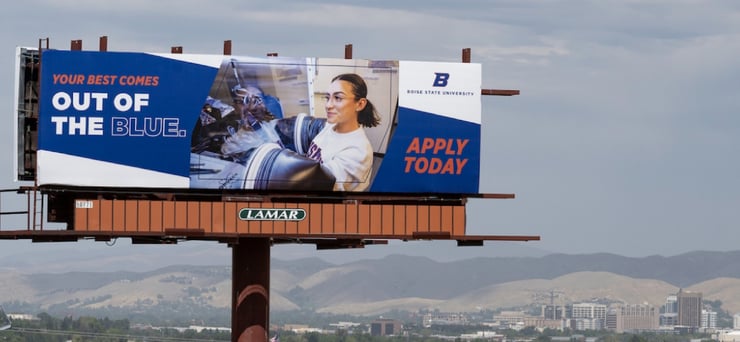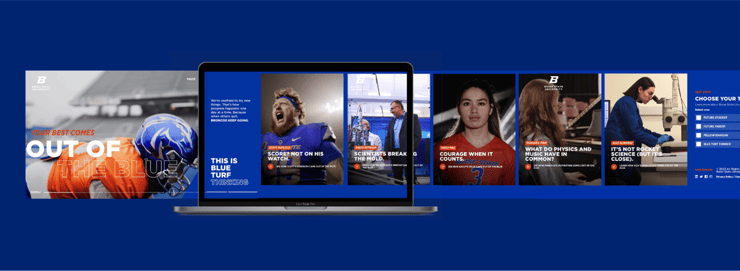A few months ago, a client launched their new brand creative, including a new identity system. I spent the better part of two days on Reddit reviewing comments and memes from students on the topic. I was also watching petition signatures on change.org escalate quickly for a few hours, only to watch them screech to a halt less than 48 hours later.
All in all, the new identity and creative has been positively received, but it’s indicative of our time as higher ed marketers: a time of increased pressure and scrutiny on marketing and communications teams from administration, faculty, students, and alumni.
It wasn’t always like this, so how did we get here?
It wasn’t that long ago that most universities didn’t market or advertise because there was no need. Enrollment was robust on most campuses, and state funding was solid for the publics. Nevermind that marketing was a bad word on campus. It devalued the university brand (or so we were convinced). Eventually, more schools adopted market research to measure awareness, perception, and brand health. As the data improved, marketing teams used it to build more robust brand strategies. And from there, more and more creative executions and campaigns. Finally, content strategies evolved, shifting newsrooms of beat writers to teams of digital and social storytellers. It’s been a long, slow burn to our current state.
This doesn’t fully answer the question of, “how did we get here?” The story sounds more akin to Hemingway’s quote regarding bankruptcy in The Sun Also Rises:
“How did you go bankrupt?”
“Two ways. Gradually, then suddenly.”
This made me wonder if there was an inflection point, and I think I found one. Or, better stated, a combination of three factors that lead to this increased pressure on university marketing and communications to get things exactly right.
1. The Recession
In the wake of the economic recession in 2008, states began to cut funding for higher ed. For a couple of years, there was an uncertainty of whether the decline in funding was temporary or if it’d become the new norm. By the early 2010s, it was apparent this was the new norm in most states. Since then, state funding has dropped by more than $9 billion since 2008 when adjusted for inflation.
2. Better Data (and a lot more of it)
Google Analytics launched in 2005, and by the early 2010s it had wide adoption. Even those not using the tool we’re at least aware it existed. By the mid-2010s, social media analytics became more robust and specialized, and programmatic advertising made campaigns more targeted and increasingly effective. With campus communities now accustomed to marketing and advertising, their expectations for it to be even better began to rise dramatically. But there are innate flaws with all of these measurement tools, especially in higher ed marketing — more on that in a minute.
3. Fewer Students
This is one we all know too well by now: far fewer students are coming of college-age. It’s this factor that has many colleges and universities revisiting brand strategies, creative campaigns, and testing new geographic markets. When you combine that economic downturn, the pervasiveness — and accessibility — of big data, and the generational reality of fewer college-bound students, you can nearly hear the reaction now: “We need more students, marketing has all the tools they could ever need, why aren’t all their efforts working with 100% effectiveness?”
Fair or not, this perception isn’t going away anytime soon. So, what can we do about it?
Own Up to the Flaws in the Data
Yes, we have more data at our disposal today than ever before. But there are two core issues with analytics tools. They both involve humans. Fake and real humans, to be exact. Take a look at any account’s Twitter follower growth chart over time and you’ll see periodic dips in follower count. That’s twitter killing off bots. Fake accounts make up some portion of our data across every platform. Does that mean you should stop using these tools? Of course not. It’s just something to keep in mind and possibly communicate in reporting.
Real humans are more problematic, though. Website traffic grows or shrinks based on content produced. (That’s the most over-generalized definition of SEO or how Google works ever, but that’s not really the lede here.) On college campuses, this is an impossible thing to control. Marcom is producing content, but so are professors. Everything has an impact — whether good or bad. The same thing happens on social media. Teams try new things every day, some work and grow reach and engagement, and some don’t. The point is, new, independent variables are introduced every day across multiple channels, making it increasingly difficult to trust the data and to understand what is working. I mean, it’s literally science.
The best marketing offices try and establish as many constants as they can, to benchmark and report on those year after year. It may be an untenable effort on some campuses, but it’s still the best course of action when it comes to data.
Proactively Communicate and Stay the Course
From conducting market research to rolling out a new creative campaign, involving the campus early on marketing initiatives is critical to get buy-in. Today’s environment requires an ongoing effort throughout the process: engage the stakeholders in research findings and share creative to get early feedback. The more data points you gather along the way, the more proof you have that you’ve done your due diligence.
If you’re working on launching a new creative or brand campaign, prep the press. Use the data you’ve collected along the way and share with campus publications and local media. Build campus ambassadors (beyond just the President) and aid them with talking points. Many times, the process on campus is more important than the final result, and the more people you have speaking the same language, the better your chances for success.
Lastly, stand behind your work and stick with it. Every big brand and creative initiative that rolls out on a college campus will be met with some level of resistance. Like the example I laid out at the beginning, you’ll hit roadblocks at launch but the more the campus community sees all the work that went in the more buy-in you’ll receive.
Test Creative (quantitatively)
This is an extra step most institutions do not take, but it’s one we really believe in. Sending creative into the market shouldn’t be done to decide which concept to use. It should be used to inform your team on what resonated best amongst target audiences. This is a nice arrow to have in your quiver.
Partner Closely with Enrollment
Arguably, this is the most difficult of the bunch. To truly market effectively today, marketing and communications and enrollment management need to be joined at the hip. The best programmatic ad platform in the world can’t tell marcom what geographic markets admissions counselors are planning to be in next month. That ad platform also won’t alert marcom to the fact that the enrollment office has already spent money on ads. This is why it’s imperative for the two offices to communicate regularly. That type of collaboration not only increases the effectiveness of marketing by creating better brand awareness where it’s needed, but it reduces wasted money and resources (and not just for ads, but for digital and print efforts too).
This is an increasingly difficult time for higher education marketers. But the bottom line comes down to understanding the data and benchmarking appropriately, opening up lines of communications, and increasing collaboration with key partners. There will always be naysayers, but be confident in the process you’ve run and the work you and your team are producing.











